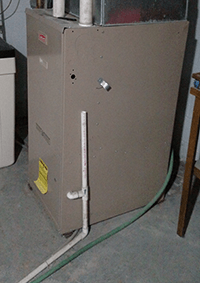Why Is My Furnace Leaking Water?
 Condensation
Condensation
Your furnace does not use water in order to operate, but water is a byproduct of the cooling process involved with your central air conditioning. The likely causes are:
- Plugged drain pan.
- Plugged drain hose.
- Rusty drain pan with a hole in it.
My furnace has a drain pan?
Yes and no. What you typically think of as your furnace is actually two components in one. The lower portion of your furnace is the actual furnace that heats the air for your home during cold months. Mounted above that is the inside section of your central air conditioning unit. Central air conditioners have two pieces, one that is outside of your home and the other is mounted above your furnace.
Basic summary of how central air works
The outside part of your central air contains the compressor and condenser while the inside part contains the evaporator coils.
- The compressor pressurizes the gas (freon) circulating it to the evaporator coils inside your home.
- The evaporator coil allows the coolant to become gaseous absorbing the heat from the air around it. The resulting cool air is circulated throughout your home using the fan in your furnace.
- The warmed coolant is returned to the outside unit where it passes through the condenser coils. Here the heated gas is returned to the liquid state, releasing its heat to the outside air.
Where does the water come from?
The water is condensation from the moisture in the air surrounding the evaporator coil. Placed below the coil is the drain pan. The idea is for the pan to direct the water to a drain hose that leads to the floor drain in your furnace room. The puddle of water on the floor is typically a result of a plugged drain pan or hose.
Call AEM Mechanical Services, Inc., at 320-587-0991 for help diagnosing and solving your leaky furnace.
About the author
Related Posts
2008 - 2020 © AEM Mechanical Services, Inc. - all rights reserved
MN License #34376PM
Privacy Policy | Sitemap
Website created by Mid Minnesota Marketing

 Condensation
Condensation